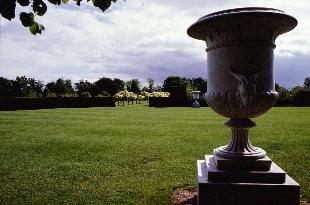 Finding the way into Sutton Place was as difficult as finding the
way out of some complex and frustrating maze.
This mansion and enormous estate of several thousand acres was the
reclusive home of oil magnate J. Paul Getty until he died in 1976, so I
suppose there was no incentive to erect road signs to attract the
commoners.
As we skirted the property for quite some
time with no luck at finding the gate, we finally pulled into a
gas station to ask directions. Men usually don't ask directions, so
you can just imagine the level of our frustration.
There was another customer at the counter who said that
he knew, but directions were hard to describe. He was planning
to visit his late mother's grave at a church nearby, so he suggested
that we follow him. After what seemed like endless turns and
twists down narrow roads, we arrived at an unmarked gate. We
were at Sutton Place. We thanked the man for his kindness, and
gave him a fine bottle of wine that one of our members had just
purchased.
Finding the way into Sutton Place was as difficult as finding the
way out of some complex and frustrating maze.
This mansion and enormous estate of several thousand acres was the
reclusive home of oil magnate J. Paul Getty until he died in 1976, so I
suppose there was no incentive to erect road signs to attract the
commoners.
As we skirted the property for quite some
time with no luck at finding the gate, we finally pulled into a
gas station to ask directions. Men usually don't ask directions, so
you can just imagine the level of our frustration.
There was another customer at the counter who said that
he knew, but directions were hard to describe. He was planning
to visit his late mother's grave at a church nearby, so he suggested
that we follow him. After what seemed like endless turns and
twists down narrow roads, we arrived at an unmarked gate. We
were at Sutton Place. We thanked the man for his kindness, and
gave him a fine bottle of wine that one of our members had just
purchased.
Traveling down the long driveway to the estate, we realized that
this was a manor house of the grandest scale, the kind of home one
might expect for one of the richest men of this century. The huge
tudor mansion was built between 1520 to 1530 by Sir Richard Weston,
one of the loyal courtiers of Henry VIII. Around 1900, Lord and
Lady Northcliffe brought in Gertrude Jekyl to design the West
Walled Garden, terraces, yew hedges, and the pool garden. Now under
the control of the Sutton Place Foundation, the house and gardens
have been going through significant restoration.
We had an appointment to meet with the head gardener, John Humphreys.
After our introduction, we were given maps and allowed to wander
as private guests around the estate. My first impression of excess
wealth seemed was reinforced everywhere, especially in the garden
sculpture. Here were huge marble urns bigger than my car,
ornaments that were probably appropriate to the scale of a manor
house of this size, but certainly not for me. One garden fountain
had gargoyles spouting water from their mouths. As I looked at the
sculpture more carefully, the faces of the gargoyles remided me
of my principal back at school, frowning and expressing his
displeasure over my decision to take this trip. There were lots of
water features, ponds and other fountains. I watched my steps
carefully so that I wouldn't fall into any of them as I had done
at Hestercombe. There were not many rhododendrons here, and we
did notice a couple of sickly plants that were rather new to
the garden. On close inspection, we discovered the reason for their
ill health. The plants had been set about three inches too deep.
Rhododendrons
have a very shallow root system, and their root systems will
smother if planted too deeply. I thought of mentioning it to
the head gardener, but decided that it would be out of place.
As usual, the Gertrude Jekyl designs were charming. She was certainly
a talented lady, and no wonder most of Great Brittain's gentry sought
her expertise. The iris and lupines in the West Walled Garden were
putting on a grand show when we were there, but the Rose Garden would
not be in bloom for several weeks. My favorite spot was a peaceful
sitting room entwined with wisteria. Peering through the
fragrant clusters of blue wisteria blossoms
framing the Pool Garden, I imagined
that J. Paul Getty probably came here when he wanted to forget the
frantic pace of big deals and high finance. I found the rest of the
gardens at Sutton Place impressive, but
uncomfortable and ostentatious. They were not for me.
It is a good thing I was not born
into money.
|